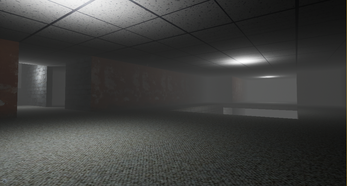Fungicide
3D FPS

Fungicide is a first-person shooter video game I started working on in fall 2021. The game is built in Unreal Engine 4, and is graphically inspired by early 3D games such as Half-Life, Sonic Adventure, and Shenmue, though with a grungier and more distorted texture library. The game has two versions, the early arcade/score-based version, and the later exploration focused version.
Arena Version (2021-2022)
Mechanically, the game started as an attempt to create a single-player experience similar to QuakeCraft, a minigame on the Hypixel Minecraft server. This meant hyper powerful attacks that can take down enemies in a single hit. This version was score-based and featured a couple of maps. This version is pretty rough overall, I never really made it to the polish stage.
Exploration Version (2023-)
In summer 2023, I decided to pick up development again, reworking the game into more of a linear experience. This version focuses more on animation and consistency, attempting to produce a small, polished experience. This version uses Project Borealis's character movement plugin, which attempts to port most of the Source Engine (Half-Life 2, Portal, CSGO) movement to Unreal. I really like the Source Engine, and would be considering it for development if it weren't such a pain to get a hold of.
Mapping Tools
The primary difficulty with development has been finding a suitable mapping tool. There are a lot of mapping tools out there, but either are a pain to use with Unreal, or don't gel with my workflow.
Blender + Sprytile
The first tool I used was Blender with the Sprytile plugin, which allows one to design models using pixel-art tiles. This method worked, but produced maps with way too much geometry. The primary benefit of this method was that every tile was pixel perfect, so you wouldn't have multiple sizes of pixels. Additionally, it was not suitable for multi-floor levels, as tiles become obstructed. The church level in the Arena version, along with parts of the Harbor map were made with this method.
Blender Freeform
Another tool I tried using was Blender without sprytile. This was done by simply dragging and moving cubes. This method was not pixel-perfect, and was a pain to use. The hidden backrooms map in the arena variant was made using this method.
Hammer + Blender + SourceIO
I also tried Hammer, Valve's level design tool for the source engine. This tool is an absolute joy to use, but exports stuff in esoteric formats, which can't be imported into Unreal directly. I was unwilling to pay for the Hammuer plugin, so I attempted to use SourceIO and Blender to convert to FBX before importing into Unreal. Additionally, it was a pain to import images into Hammer to use as textures, so I needed to change them all in Unreal. This was not fun to use, so I didn't!
Trenchbroom + Hammuer
TrenchBroom is an open source mapping tool for Quake and other Quake-based games. It's been updated to offer modern features, such as .png textures, which makes it an extremely attractive tool. Its interface also shares a lot of similarities with Hammer, which was attractive. While it does support .obj export, this was a pain to use, so I finally broke down and bought Hammuer. This lets me import maps into Unreal relatively easily. It's still a pain, but a usable pain. With a mapping tool selected, I just need to make some usable maps!